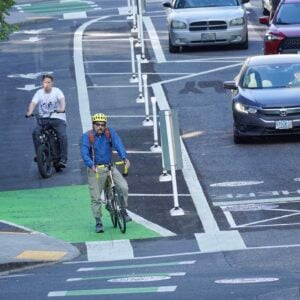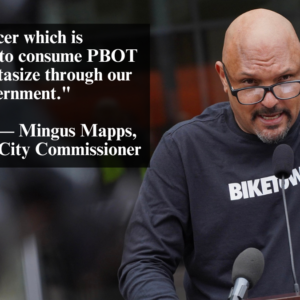
A new research paper published last month in the Journal of Physical Activity and Health focused on how Portland’s investments in bikeways relate to savings in health care costs, fuel purchase savings, and other benefits. The paper (PDF here) sought to monetize the return on investment garnered by the City of Portland for money spent on bikeway miles in the past and what potential returns might be based on projections of future spending.
“By 2040, investments in the range of $138 to $605 million will result in health care cost savings of $388 to $594 million, fuel savings of $143 to $218 million, and savings in value of statistical lives of $7 to $12 billion.”
The paper is authored by Thomas Gotschi, a researcher with the Institute of Social and Preventive Medicine at the University of Zurich in Switzerland.
Here’s a snip from his opening paragraphs (emphasis mine):
“Benefits of bicycling—such as the gain in physical activity and emission-free transportation—are generally understood, at least in broad, qualitative terms, and undisputed. Nonetheless, spending money on bicycle infrastructure is often a low priority compared with investments in roads, public transportation, and other government expenditure. Although traditionally debated within the framework of transportation policies, more recently the idea of considering investments in walking and bicycling as a measure of disease prevention has gained traction… A better understanding of the cost-benefit relationships of bicycling investments would be helpful to justify such initiatives.”
Gotschi’s findings confirm what we already know — that the miniscule investment we have made (and plan to make) in bikeways provides an excellent value for our transportation dollar; particularly in terms of reduced health care costs and fuel savings.
Here is the summary of Gotschi’s findings:
By 2040, investments in the range of $138 to $605 million will result in health care cost savings of $388 to $594 million, fuel savings of $143 to $218 million, and savings in value of statistical lives of $7 to $12 billion. The benefit-cost ratios for health care and fuel savings are between 3.8 and 1.2 to 1, and an order of magnitude larger when value of statistical lives is used.
For some perspective, Portland estimates that all the bikeway infrastructure we have built to date has cost us about $65 million. To analyze the return on investment, Gotschi used the three levels of investment outlined in the 2030 Bike Plan (see Table 1 in his paper). His findings show that at two of the three levels (the “basic” and “80%”), Portland would break even on their bikeway investments by 2015.
In his conclusion, Gotschi notes that this is the first study of its kind and that Portland’s investments in bikeways, “are cost-effective, even when only a limited selection of benefits is considered.”
Read more about the study, and download a copy of it here.
— H/T to the Bicycle Transportation Alliance for bringing this paper to my attention.






Thanks for reading.
BikePortland has served this community with independent community journalism since 2005. We rely on subscriptions from readers like you to survive. Your financial support is vital in keeping this valuable resource alive and well.
Please subscribe today to strengthen and expand our work.
This is how the efforts to build bicycle infrastructure, and the campaigns to get more people on bikes needs to be framed – as an public investment with a guaranteed return. Just like good schools benefit even those who don’t have kids, Bicycle infrastructure improvements have a larger public benefit, even for those who don’t ride.
While I believe in the cause, analyses such as these always make me cringe. Savings are almost invariably overblown and costs severely underestimated. Bicycle infrastructure is an investment in the community on many levels, but to attach hard numbers to a mostly intangible ROI with myriad confounding factors is folly and intellectually dishonest.
I know that we (as advocates) need to point to some greater reward down the line in order to sway the naysayers, but making up numbers (and it is a fabrication; I don’t care who is behind the figures) is exactly what the other side does to shut us down. We should not stoop to their level.
Fabricating data is dishonest. But creating a good faith estimate based on available data is useful information. Of course it needs to be viewed as what it is – an estimate based on available data. But to dismiss it outright because it can’t possibly be proven to be 100% accurate is throwing out the baby with the bath water.
Not mentioned is if an investment of that money in other areas would have better outcomes.
Well, the attempted scope of this study is already an epistemological impossibility. Analyzing other cases would be for other studies.
Yea but everyone makes these kind of costs estimates for all sorts of projects. And while they may not be totally sound it’s sorta the best we got. Like all the light rail/streetcar funding is predicated on cost savings/development potential that are just as hard to calculate.
I’m really glad to see that he included SmartTrips as part of the cost analysis. Other cities shouldn’t think that they will see similar return on investment if they don’t do the serious marketing/education work that goes along with infrastructure.
This is an interesting study. Sounds like the basis for a conservative argument for bike infrastructure. Hopefully someone will use this as a platform for more funding. For instance reallocating 25% of trimet’s business tax to bike projects around the area might be a better return on investment than what we get now.
New numbers!! This is super important work, thanks Thomas Gotschi.
Two big articles out on obesity this week. Would be nice to see public health funds going towards cycling infrastructure instead of drawing solely from transportation & recreation funds.
Look at how Kitzhaber is proposing to reorganize much of what the state does. Someone needs to be lobbying him hard on this.
I would love to see a thorough, well argued and documented study by Wayne Meyer on the purported uselessness of this kind of research–not just a paragraph. Terms like “epistemological impossibility” don’t mean much. More light, less smoke please. When we have your study (article, paper, whatever), Wayne, then we can discuss it and perhaps draw some interesting conclusions.
Whew, you sure told me! My butt is stinging from that quip. I suppose “confounding factor” was too murky for you. But just in case you need more, “Those who cannot remember the past are condemned to repeat it” (Santayana, Life of Reason or The Phases of Human Progress).
The Case of Transportation: http://citeseerx.ist.psu.edu/viewdoc/summary?doi=10.1.1.145.4994.
TriMet’s dashboard tells a nice story of overestimation of benefits and underestimation of costs: http://trimet.org/about/dashboard.htm. Google “WES” for yourself for a nice list of overestimation of benefits.*
Truth and Lies about Megaprojects: http://flyvbjerg.plan.aau.dk/Publications2007/InauguralTUD21PRINT72dpi.pdf.
Are estimates important? Yes. Are estimates such as Gotschi’s important? Maybe. Do you get suspicious when politicians start throwing around numbers for projects you don’t like? I sure do. But here’s the difference: when people start throwing around numbers for projects that I do like, I still remain suspicious.
I propose that we choose a different tack for advocating bicycle infrastructure (and this is the subtext of my original comment). The numbers arguments are just a battle of who can talk loudest. Rather than rely on numbers (“figures don’t lie, but liars sure can figure”), objective principles of design will speak more strongly than some numbers in the future. Devoting large swaths of urban square footage to inefficient transit modes is a poor investment.**
*My optimism bias leads me to believe WES is a good thing and that we will ultimately be thankful for it, even if it is overpriced and underutilized now. But I realize that I am reasoning emotionally and don’t have a nice objective cushion on which to rely.
**Or, maybe I am making the typical engineer’s mistake of thinking that people actually use some semblance of rational reasoning in their decision process. I concede that.
Wayne, my only interest is in seeing this study–or any study of its type–subjected to thorough rational critique. If its conclusions survive, great; if they don’t, then we know the route not to take.
The documents you’ve provided will make for some interesting reading.
As far as bike infrastructure goes–I know the bike ridership mode for the inner districts of Portland nowadays is as high as 29%, with the very modest infrastructure investments that have already been made. There must be some way of quantifying the benefits (if indeed there are any) of these investments. Gotschi’s approach might not be the best one or the right one, but then it behooves us to develop some method of cost-benefit analysis that is appropriate.
If however no such analysis is appropriate, then that says more about the larger applicability of cost-benefit analysis than about Gotschi’s study in particular.
But if no larger cost-benefit analysis is appropriate (or possible), then how do we rationally evaluate the utility of various transportation modes? You yourself have mentioned “inefficient transit modes”–I assume you mean fossil fuel powered vehicles. Without larger cost-benefit analysis how can we even conclude that there are any inefficient modes?